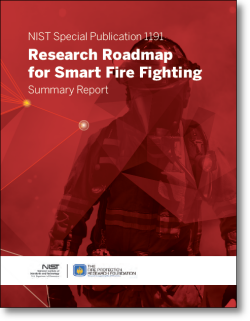June 25, 2015

The National Institute for Standards and Technology has published a Comprehensive Report for Smart Fire Fighting which includes all areas of fire prevention and protection engineering and fire service emergency response, and it addresses all phases of resilience (i.e., pre-incident, during an incident, and post-incident). Smart Fire Fighting will transform traditional fire protection and fire fighting practices to ensure the flow of critical information where and when it is needed.
In 2013, fire departments in the United States responded to more than 480,000 structure fires, resulting in approximately 2,850 civilian fatalities, 14,000 injuries, and estimated property losses of $10 billion dollars. More than 30,000 fire fighters were injured on the fireground. These losses can be significantly reduced by exploiting new opportunities in technology development, including cyber-physical systems through the fusion of emerging sensor and computing technologies with building control systems, fire-fighting equipment, and apparatus. Cyber-physical systems will revolutionize fire fighting through a range of approaches most notably represented by collecting the data globally, processing the information centrally, and distributing the results locally.
Smart Fire Fighting Fire prevention is an essential element of Smart Fire Fighting. This will be achieved by enhancing the power of information through enhanced data gathering, processing, and targeted communications. An evolving range of databases and sensor networks will be tapped to create, store, exchange, analyze, and integrate information into critical knowledge for the purpose of Smart Fire Fighting. Engineering, developing, and deploying these systems will require new measurement tools and standards, among other technology developments. This roadmap identifies and addresses high-priority measurement science research challenges, technical barriers, and related research and development gaps that hinder widespread application of Smart Fire Fighting technologies and systems to enhance building and community fire protection.
There are more than 30,000 fire departments in the United States and almost as many operating procedures for fighting fires. Why is that? Because there are no national standards for such procedures! While standards exist for training, equipment, and other key focus areas, tactics and strategies typically are controlled by three major factors: (1) the experience and judgment of the IC; (2) limited data that are either visually observed or derived from the operating environment, such as a fire alarm panel or fire command center; and (3) jurisdictional standard operating procedures. At a fire incident, the variation in these factors can be tremendous. If the fire service is working without specific and reliable information regarding the fire location, history, and projected growth; the building geometry and its contents; the location of occupants and fire-fighting personnel; the fire suppression activities and their consequences; and the status of fire protection assets, then their response strategy will continue to rely on experiential judgment.




